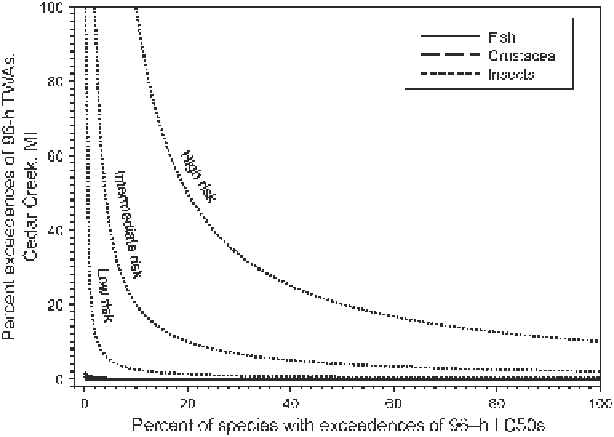Environmental Engineering Reference
In-Depth Information
Fig. 8
A joint probability curve for estimated 96-h time-weighted mean concentrations of chlor-
pyrifos in Cedar Creek, MI modeled from Jan 1, 1961 to Dec 31, 1990. For details of the modeling
of exposures, see Williams et al. (
2014
)
Risks from repeated exposures to CPY
. The risks of CPY were further evaluated by
considering the duration of exposure and the time between exposures that were
predicted by SWAT for watersheds in Michigan, Georgia, and California. The anal-
ysis was conducted using the RADAR program (ECOFRAM
1999
; Williams et al.
2014
). RADAR analyzes the daily time-series of exposure estimates to identify
events in which concentrations exceed a pre-defi ned threshold, calculate the dura-
tion of each event, and determine the time between events (recovery time). The
NOAECeco from the cosm studies, 0.1
g L
−1
, was used as the threshold in this
analysis. The full results are presented in SI Appendix E of Williams et al. (
2014
).
No events occurred in the Georgia watershed, and none in the Michigan watershed
when the 28-d half-life was used. With a 96-d half-life, there were three events in
the Michigan watershed, all of 1-d duration and with at least 1,240 d between events.
The short event durations and long intervals between events imply that no exposures
in the Michigan watershed would result in ecologically signifi cant effects.
Over the 10-yr simulation in the California watershed, there were 10 events (28-d
half-life) or 35 events (96-d half-life), in which concentrations exceeded 0.1
μ
g L
−1
.
The minimum and median event durations in the California watershed were 1 d for
both half-lives, and the maximum event durations were 11 d and 15 d using the 28-d
and 96-d half-lives, respectively. Recovery times ranged from 1 to >1,892 d. Using
either half-life, recovery times in half of the events were greater than 14 d, long
enough for toxicodynamic recovery from AChE inhibition in crustaceans and
insects (Sect.
2.2
). About one-third of these events had recovery times greater than
56 d, long enough for toxicodynamic recovery in fi sh (Sect.
2.2
) and for ecological
μ

Search WWH ::

Custom Search